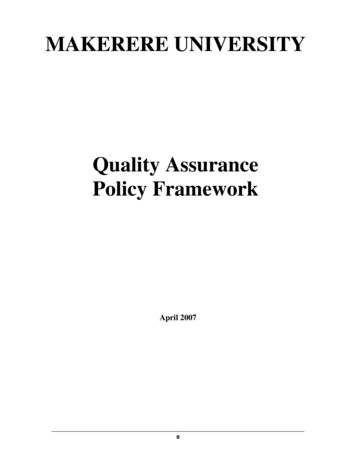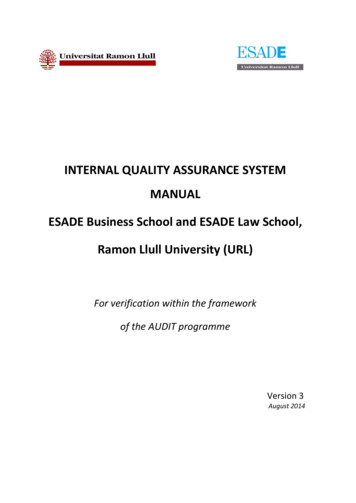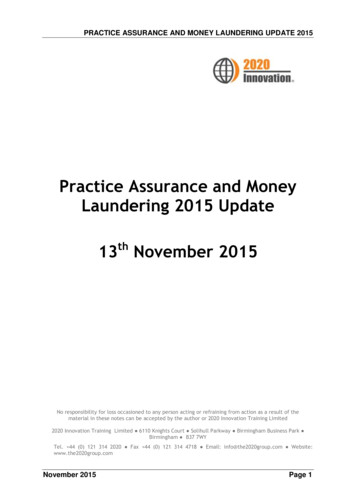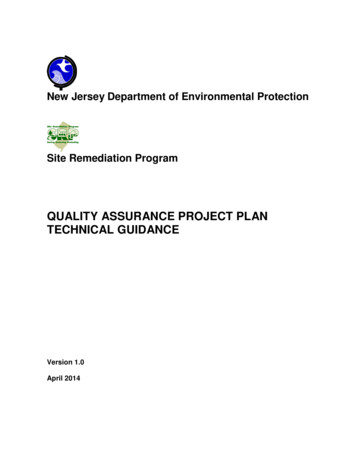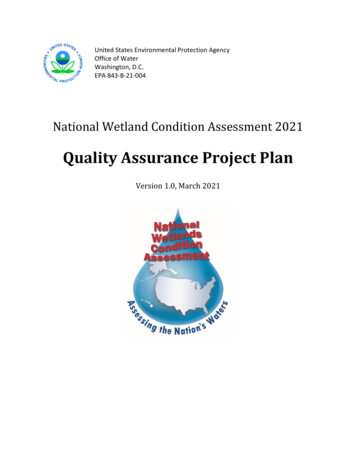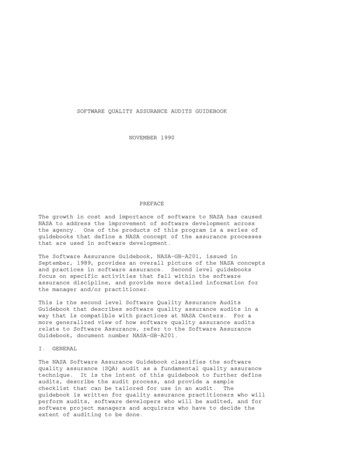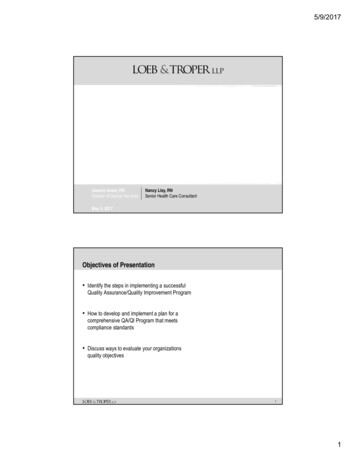
Transcription
5/9/2017Strengthening Your QualityAssurance Programin Assisted LivingJoanne Jones, RNDirector of Clinical ServicesNancy Lisy, RNSenior Health Care ConsultantMay 5, 2017Objectives of Presentation Identify the steps in implementing a successfulQuality Assurance/Quality Improvement Program How to develop and implement a plan for acomprehensive QA/QI Program that meetscompliance standards Discuss ways to evaluate your organizationsquality objectives11
5/9/2017Participant Survey Who has a functioning quality assurance (QA) program? Do you have a documented plan? Do you have a QA/quality improvement (QI) committee? How do you identify and implement documented initiatives?–Do you base goals on measureable data? How do you measure performance?–Do you continue to monitor once goals are met?–How do you document your program and initiatives/success?oWhat do you do with that documentation?2Terms used for Quality Activities Quality Control (QC) Quality Assurance (QA) Quality Improvement (QI) Continuous Quality Improvement (CQI) Total Quality Management (TQM)32
5/9/2017Quality AssuranceDefinitiona program for the systematic monitoring and evaluation of the variousaspects of a project, service, or facility to ensure that standards of qualityare being met *Focus reactive retrospective policing and at times punitive Determining who was at fault after something went wrong.* Merriam Dictionary4Quality ImprovementDefinitionto enhance in value or quality: make better*Focus : Measuring where you are Identifying ways to make things better Avoid attributing blame Create systems to prevent errors from happening* Merriam Dictionary53
5/9/2017Why Implement a QA/QI Program State Regulatory Requirement Means to identify potential compliance issues Monitoring activities can identify individual or systematic performance issues (QA) Means to identify opportunities to improve efficiency/effectiveness of practices (QI) Improve resident satisfaction and quality of life Quality metrics are important to managed care payers6QA Regulatory RequirementsAdult Care FacilitiesChapter 735, Section 1 of Social Services Law 461-a(2)(c): Requires operators of adult homes and residences for adults to develop, biannuallyupdate and implement plans for quality assurance activities for each area of facilityoperation (Effective August 2, 1997)74
5/9/2017QA Regulatory RequirementsAdult Care Facilities18 NYCRR 487.10(d)(5)(ix): At a minimum, the operator shall maintain records documenting the development,implementation and, at a minimum, the bi-annual updating of quality assurance activitiesfor each area of facility operation. These must include, at a minimum, the development and maintenance of performancestandards, measurement of adherence to such standards and to applicable state andlocal laws and regulations, identification of performance failures, design andimplementation of corrective action.8DAL 16-12: Guide for Quality AssuranceApril 28, 2016 Dear Administrator Letter informing ACF operators, administrators and staff of aheightened focus on QA/Quality Improvement(QI) activities by NYSDOH Division ofACF and Assisted Living Surveillance Serve as a resource to understand the basic principles of QA/QI and how to applythose principles when developing QA/QI plans for each area of operation in thefacility95
5/9/2017Regulatory RequirementsIncident Management ProgramArticle 11, Social Services Law, Section 490 Pertains to Vulnerable persons (person who due to physical or cognitive disabilities, or theneed for service or placement, is receiving services from a facility or provider agency) Facility or Provider Agency defined to include: ACFs (Adult Home/Enriched Housing 80 beds with at least 25% of the residents with seriousmental illness, but NOT including ACF with 55% of total capacity of beds authorized as ALPbeds) Under conjoined jurisdiction of NYS DOH and Justice Center for Protection of people withSpecial Needs10Regulatory RequirementsIncident Management Program All reportable incidents are identified and reported timely All reportable incidents are promptly investigated Reportable incidents and patterns/trends are reviewed to identify preventive andcorrective actions Incident Review Committee including members of governing body, direct support staff,licensed health care practitioners, service recipient, family representative, consumer(NOT Director)116
5/9/2017Benefits of an Incident (or Accident) Management ProgramEven if formal program not required for your ALP: Per 18 NYCRR 487.5A: Resident shall have the right to receive courteous, fair and respectfulcare and treatment at all times, and shall not be physically, mentally or emotionally abused, orsubject to any occurrence which would constitute a reportable incident. A resident must have the right to have his/her version of the events leading to an accident or incident inwhich such resident is involved included on the reports of such accidents or incidents. Per 18 NYCRR 488.5: Each resident has the right to: to receive courteous, fair and respectful care and treatment, and not be physically, mentally or emotionallyabused, or subject to any occurrence which would constitute a reportable incident; have recorded on the program's accident or incident report the resident's version of the events leading tothe accident or incident Standard Part of QA/QI Incidents and patterns/trends are reviewed to identify preventive andcorrective actions (Facilitated by an established program specific to incident/accident reportingand investigation protocol)12QA/QI Program Components QA/QI Plan Establishes scope and activities of the Program Identifies roles and responsibilities QA/QI Committee or Team Provides leadership and direction Determines resources needed QA/QI Model Defines Facility’s process for approaching QA/QI activities137
5/9/2017QA/QI Plan Provides a framework to ensure delivery of quality care and services and to facilitate theestablishment of QA activities. Effective plans will: Define goals and objectives Assign roles and responsibilities Identify monitoring activities–required to be updated at least twice per year Identify model for conducting QA/QI activities14Components of ACF QA/QI Plan Identifying ongoing monitoring activities Compliance Resident Satisfaction Managing Complaints Managing Incidents Focused Initiatives Staffing/Workforce Issues Person Centered Care concerns Care Transitions158
5/9/2017QA/QI Committee/Team QA/QI Committee is not required by ACF regulation Effective means to organize quality activities Provides structure and definition to a QA/QI Program Includes key staff from each operational area Resident representation Assists in identifying trends/improvement activities Review findings and improvement activities Evaluate effectiveness of corrective actions Provide agreed upon recommendations16QA/QI Process Recognize/Identify areas for improvement Include areas that are high volume, high risk, problem prone Prioritize by importance Identify goals Identify method to collect data Include staff at all levels Conduct root cause analysis Identify improvement actions to be implemented Assign responsibilities Determine how improvement will be measured Establish reporting process179
5/9/2017QA/QI ModelPlanDoActCheck18Plan Identifying Areas for ImprovementPlanDo Resident Council Meetings Food Committee minutesActCheck Suggestion Boxes (Resident/Staff) Grievances Family Meetings Ongoing conversations with residents, family, staff DOH Inspection Reports /Regulations** OMIG Audit Protocol; Assisted Living Program (ALP), Revised March 10, 2017, Office of the Medicaid Inspector General1910
5/9/2017Plan Identifying additional quality metricsPlanDo Routine data collection Used to identify opportunities for improvementActCheck Used to market facility–Payers–Prospective admissions Examples:–Hospital transfers–Infection rates–Weight loss20Plan Collect/Analyze data to identify the opportunity forPlanDoimprovement Staff interviews Conduct auditsActCheck Resident interviews Conduct root cause analysis Drill down to gain understanding of the cause–WHY? WHY? WHY? Identify what can/should be done to improve–Prevent reoccurrence–Improve the outcome/performance2111
5/9/2017Do Develop Action PlanPlanDo create/revise polices implement new/revised proceduresActCheck educate staff Establish timeframe and staff responsible to implement change Implement action plan22Check Identify effectiveness of action planPlanDo Establish means to collect data to monitor results Identify staff responsible to collect dataActCheck Staff or resident interviews Audits Analyze Results Report to QA/QI Committee/Team2312
5/9/2017Act Analyze results of the action planPlanDo Did changes work? No Cycle begins again Yes Maintain and determine frequency of monitoringto evaluate ongoing improvementActCheck If successful What’s next?24QA/QI – Where to Start Master the process with well defined benchmarks Regulatory Compliance Potential Vulnerabilities–Past survey results–OMIG Audit ProtocoloInterface with your licensed agency for:–Patient record–Medical Evaluation–Medical Reassessment–Nursing, functional and social assessment/reassessment–PRI/UAS–RUG II/rate code billed/billing when resident in other facility–Plan of Care & services rendered–Personnel requirements2513
5/9/2017QA/QI – What To Do Next Prioritize initiatives: Residents requests/preferences Look at Industry changes movement towards managed care Common characteristics of residents Need for specialty care Improving outcomes Avoiding higher level of care Preventing hospitalization Use available resources Center for Excellence in Assisted Living (Coalition includes Leading Age)26Common Issues for QA/QI Projects Medication ManagementPatient Centered Care/PracticesCare Coordination/Care TransitionsStaffing/Workforce First aid training (487.9) (recommended for Enriched Housing) Acuity of residents Continuity of Care Emergency Preparedness2714
5/9/2017Group Exercise Review scenario provided at each table Using the Plan/Do/Check/Act model Identify how you would implement a QA/QI initiative addressing the issue28Final Words of Wisdom QA/QI Program can be a useful management tool Keep it simple Focus activities Involve staff at all levels Share the results with staff Foster culture of Quality Improvement2915
5/9/2017Final Words of Wisdom“AristotleExcellent firms don't believe inexcellence - only in constant improvementand constant change.“““Quality is not an act, it is a habitTom Peters30Thank you for participating.Q&A session?If time does not permit us to answer your question or ifyou have any follow-up questions, please contact:Nancy Lisy RNJoanne omTel: (212) 697-3000, Ext. 115Tel: (212) 697-3000, Ext. 1023116
5/9/2017 4 6 Why Implement a QA/QI Program State Regulatory Requirement Means to identify potential compliance issues Monitoring activities can identify individual or systematic performance issues (QA) Means to identify opportunities to improve efficiency/effectiveness of practices (QI) Improve resident satisfaction and qual
